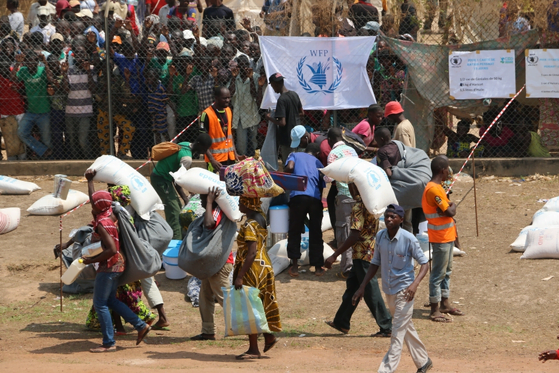The director of the World Food Program in Chad stands in an empty warehouse and warns us of a looming catastrophe. But will the world listen?
The crises in the Central African Republic and South Sudan are placing a heavy burden on humanitarian operations in the region. The World Food Program and the UN Refugee Agency are being forced to cut rations for about 800,000 refugees in Africa.
Across Africa, 2.4 million refugees in some 200 sites in 22 countries depend on regular food aid from the World Food Programme. Currently, a third of those refugees have seen reductions in their rations, with refugees inChad facing cuts as high as 60 per cent.
Supplies have been cut by at least 50 per cent for nearly 450,000 refugees in remote camps and other sites in the Central African Republic, Chad and South Sudan. Another 338,000 refugees in Liberia, Burkina Faso,Mozambique, Ghana, Mauritania and Uganda have seen their rations reduced by between five and 43 per cent.
In addition, a series of unexpected, temporary ration reductions has affected camps in several countries since early 2013 and into 2014, including in Uganda, Kenya, Ethiopia, Republic of Congo, Democratic Republic of Congo and Cameroon. Some cuts were also due to insecurity that affected deliveries.
“The number of crises around the world is far outpacing the level of funding for humanitarian operations, and vulnerable refugees in critical operations are falling through the cracks,” said High Commissioner for Refugees António Guterres. “It is unacceptable in today’s world of plenty for refugees to face chronic hunger or that their children drop out of school to help families survive,” he said, calling for a rethink on funding for displacement situations worldwide.
The agencies need a total of $224 million between now and December to restore full calorie counts to vulnerable and food insecure refugee populations in Africa. If they do not secure that funding, the consequences could be dire. Stunting — which occurs when children do not get adequate nutrition during a critial period of childhood — is already a problem. It results in poor physical and intellectual development, and could have devastating social consequences for a generation. Again, here’s the WFP
Nutritional surveys conducted between 2011 and 2013 showed that stunting and anaemia among children was already at critical levels in the majority of the refugee sites. Only one of 92 surveyed camps, for example, met the agencies’ goal of fewer than 20 per cent of refugee children suffering from anaemia. And fewer than 15 per cent of camps surveyed met the target of less than 20 per cent stunting among children. The surveys also showed that acute malnutrition levels among children under five years of age remain unacceptably high in more than 60 per cent of the sites.
$224 million is not an enormous sum, particularly when spread among many donors. The consequences of continued food shortages in this region could sow instability, hinder economic development and prevent durable solutions to the crisis in South Sudan and CAR. Donors need to pony up. And fast.
